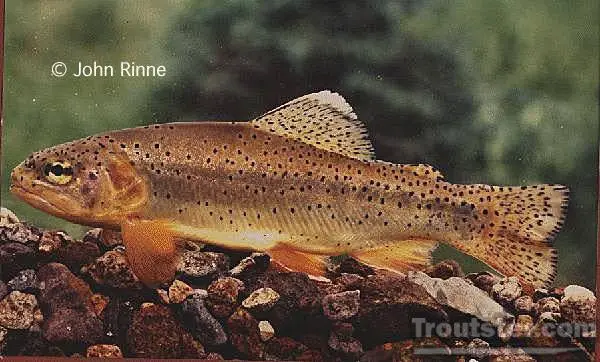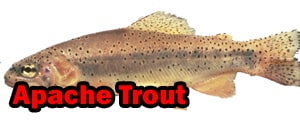This post was last updated on August 17th, 2021 at 08:38 pm
The Apache Trout is one of the only two trout considered native to the waterways of Arizona. Here, we will talk about how to identify this critically endangered species of trout, where it might be found, it’s typical growth, breeding habits, and more. We will also discuss its history in Arizona waterways, current threats, endangered status, and more.

Apache Trout Facts
Apache Trout Identification
Apache Trout is the common name for Oncorhynchus apache. Anglers can identify this species by its golden-yellow color and darker, evenly spaced spots that cover most of its body (with exception of the belly). These spots may or may not extend to the tail and dorsal fins of the fish. The belly on this fish takes on a golden color. On each sides of the pupil, you might see a small black spot, which makes it appear that each pupil has a black stripe running through each of its eyes. Look for a head and back that both appear dark olive in color, as well. Some of these fish may sport a mark under their lower jaws which can be colored from yellow to gold.

Where do Apache Trout Live?
Apache Trout are native only to very clean and cool running freshwater mountain streams. Historically, they have only been found in streams near the White Mountains in the Salt River and Little Colorado River watersheds. Their habitats in these streams range from forest to marshy and swampy areas. There are some lakes in the area that boast the AP. trout populations, but most of these have been stocked. Since they have been declared an endangered species, these trout have also been introduced to other areas where they are not native fish. Although this was a gesture originally meant to help keep the fish alive, some of these introductions have actually worked to muddle the gene pool of the Apache trout.
Apache Trout Size
Apache trout can grow larger in their native areas in the wild. In this cases, these fish may measure up to around 40 cm, and can reach up to 61 cm at their largest. However, in other areas, they are normally only found up to a length of 25 cm when mature. As a general range, these fish may weigh between only 6 ounces, but up to 6 pounds in native areas. In the wild, these fish survive off of aquatic and land insects, and may also dine on other fish that are smaller in size, or on plankton.
Apache Trout Spawning
One of the reasons the preservation of this natural beauty has been so difficult is because they only spawn once in their lifetime, and reach maturity after three years of life. From March to June, these trout spawn in several Arizona streams where they are either native or have been introduced. The size of the female determines how many eggs she will produce during spawning, with larger trout producing more eggs. It takes around a month for the eggs themselves to mature once produced. These fish may also interbreed with other trout species in the area.
Hybridization
As mentioned above, these trout have been known to sometimes interbreed with other species of trout. In areas where this type of trout has been both native and introduced, this has been a real problem. Types of trout that the Apache trout might interbreed with include rainbow trout and cutthroat trout. When this type of hybridization occurs, populations of both the Apache and the other species of trout are seen as being contaminated with genes of the other species. In some areas, these types of hybrids have been exterminated, or populations of trout that are found to be interbred between species have been exterminated for the good of the Apache trout species and gene pool.
History of Apache Trout
The history of the Apache trout in its native area is long and proud. Native Americans once harvested this type of fish. When many white settlers moved westward, through Arizona, they fished this trout (which was, upon their arrival, very abundant in its native streams) to near extinction. Because of this, this species of trout has been on the endangered species list and protected under federal law since the first endangered species act was passed.
Are Apache Trout Endangered?
Today, thanks to recovery efforts in its native streams and beyond for years, the Apache trout has been downgraded from endangered to threatened. Most of the streams where these trout have been or are found have been closed to all fishing, or there is a strict catch and release policy for these types of fish (when wild) in other areas. In some areas where these fish are not found natively, and they have been stocked for sport, some limited fishing is allowed. Both the Native Americans in the area, as well as environmental organizations and the federal government continue with preservation, protection, and recovery efforts for this species of wild stream trout.
Apache Trout FAQ
Can you eat Apache trout?
We do not recommend eating Apache Trout because of their staatus as a threatened fish.
